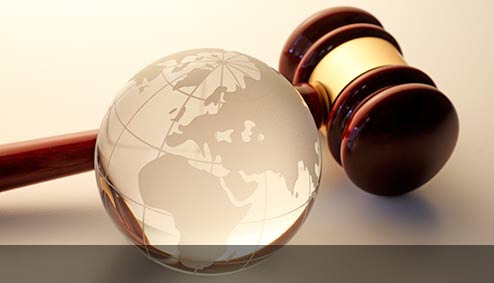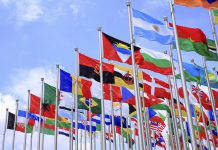This article is written by Vedant Saxena from Rajiv Gandhi National University of Law, Punjab. It delves into the 45-year long period of geopolitical tension between the Soviet Union and the United States and discusses the deep imprints it left on international ties.
Table of Contents
Introduction
Prior to the second world war, many jurists did not consider international law as a true body of law. For instance, Austin defined law as a command from a political superior to a politically inferior. He also stressed the indispensability of sanctions, for he believed that ‘it is the remedy, which makes the right real’. He did not consider international law as true law, for it lacked both these elements. All states are equally aligned, and thus sanctions hold no real power. However, the second world war led to a drastic change in such ideologies. Most of the countries began giving due consideration to the concept of self-limitation, i.e., they themselves chose to abide by rules and regulations for the reinstatement and maintenance of international peace and security.
This was the very reason why the Cold War seldom witnessed the use of weapons. After 1949, both Americans and the Soviets came to possess nuclear warheads. Both countries were well aware of the massive destruction that could be caused by it, as well as acute and lingering radiation throughout the infected areas. Moreover, even the production, experimentation and testing of nuclear weapons may cause significant loss of civilian and animal life, degradation of the environment, traumatic radiation-related mishaps, etc. However, such scenarios did not deter the 2 superpowers from stockpiling missiles and nuclear weapons. George Orwell in an article published in 1945 summed up the intensity of the cold war in the following statement: “two or three monstrous super-states, each possessed of a weapon by which millions of people can be wiped out in a few seconds.”
The Marshall plan
The Marshall plan was formulated as a consequence of the devastating impact of the second world war on Europe. It was enacted in 1948, and around 15 billion dollars of aid was lent out to the ravaged states. The plan had been formulated by the then US Secretary of state George C. Marshall. However, the plan is also considered responsible for igniting the spark of the Cold war.
The destruction that had been caused as a result of the second world war was enormous. Millions of people, both soldiers and civilians, were either killed or rendered homeless. Europe’s economy had completely collapsed. Many major cities such as Germany, Italy and Belgium, Great Britain and France, many of which were leading industrial and cultural centres, were completely shattered. A number of roads, bridges, railways and ports were destroyed, as a result of a number of airstrikes. There was heavy inflation, and famines and agricultural disasters were widespread.
Therefore, in order to put the pieces back together, leaders of various states organised a meeting around the end of 1947. One of the foremost outcomes of the meeting was the formulation of the Marshall plan. Invitations to the meeting had been extended to the leaders of the Soviet Union too. However, they did not participate in it, for they feared that the meeting might be used as an instrument by the United States to intervene in their internal affairs. The then-president of the United States, Harry S. Truman signed the Marshall plan on April 3, 1948. A number of states including Great Britain, France, Belgium, West Germany, Italy and Norway received aid in pursuance of the plan.
In George C. Marshall’s words: “Our policy is not directed against any country, but against hunger, poverty, desperation and chaos.” Although the Marshall plan could be cited as a significant success in terms of rebuilding infrastructure and economy, its political outcome is arguably not that pleasant. Refusal on part of the Soviet states to join the plan had already created boundaries and set the stage for the cold war. Moreover, one of the prominent goals of the plan was to prevent the spread of communism across the European states.
The role of the Central Intelligence Agency (CIA) is worth noting too. It was a US intelligence agency, which was employed to further America’s interests in a number of European states. However, reports suggest that the Agency had also aided an anti-communist uprising in Ukraine.
Efforts to extend the plan beyond its 4-year term went awry, with the outcome of the Korean civil war, which brought death to around 5 million people. The Korean war had been bolstered as a surrogate battleground for the cold war. Rivals North Korea and South Korea were supported by the Soviets and the Americans respectively.
Proxy wars and insurgencies
Both countries realised the importance of allies. At that time, most European states viewed the Asian and African states as underdeveloped entities, and therefore, saw an opportunity to form alliances with as many as possible. The 2 countries knew that the third world countries did not possess weapons of mass destruction, and thus, tried to assert powers over each other through proxy wars. Proxy wars were wars amongst third world countries, which were funded and supported by the 2 superpowers against one another.
For instance, the Angolan civil war (1975-2002) was a long drawn battle between the Angolan socialist government, and the anti-communist National Union for the Total Independence of Angola (UNITA). While the Angolan government was supported by the Soviets and the Cubans, UNITA garnered support from the Americans and the South Africans. UNITA gained victory in 2002, but not before the loss of 5 lakh lives and over one million internal displacements. The Korean war was also bolstered as an instrument for furthering the outcome of the cold war. Rivals North Korea and South Korea were supported by the Soviets and the Americans respectively. Approximately 5 million people were killed. In 1949, after a long wait of 22 years, the Chinese civil war came to an end with the victory of the communists. The 2 superpowers also knew that in order to form alliances, it was necessary that they garner ample support from the governments of the third world countries.
Thus, in order to undermine the unsupportive governments, the 2 countries supported belligerent and insurgent groups. For instance, in the Namibian war of independence (1966-1990), America supported the main belligerent group South African Defense Forces (SADF) in its struggle for segregating the region of South West Africa (now known as Namibia) from British-influenced South Africa. Similarly, it supported right-wing rebel groups in their attempt to undermine the Nicaraguan government. American president Richard Nixon feared that “defeat for the rebels would probably lead to a violent Marxist guerrilla movement in Mexico and in other Central American countries“, and therefore, America had intervened. The proxy wars were a marred blot upon international peace and security, and severely deterred relations between both the third world countries and the European giants.
The Hungarian revolution of 1956 was an image of Soviet oppression that furthered the strain on its ties with America. However, the uprising did not involve much American action. Commencing from October 23, 1956, the Hungarian streets were greeted by thousands of protesters demanding a more democratic system of government rather than a Soviet dictatorship. Although initially offering a peaceful settlement of the problem, the Soviets eventually took to their bloody ways of suppression and crushed the Hungarian uprising once and for all. The Hungarians developed hostilities against the Americans on account of their inaction.
The Israel-Palestine conflict
The 2 superpowers turned the Middle-East into a fertile ground for the cold war. The impact it had on the Israeli-Palestine conflict could be divided into 2 phases. In the first phase, both the Americans and the Soviets backed the formation of the state of Israel out of the Palestine domain, the first Jewish state to be recognized in 2000 years. According to the agreement, Israel was to occupy 55% of the territory, while the rest 45% was awarded to Palestine. The Palestinians did not accept this agreement, for prior to the formation of Israel, Palestine was an Arab-majority state.
However, Israel possessed the support of the 2 world powers, while Palestine had not garnered any major support. Moreover, Israel was also able to defeat a number of anti-Zionist states, who tried to undermine it. In the words of Khalidi, although Zionist forces were well equipped to handle the Arab threat, it was the “overt backing of the United States and the Soviet Union that gave international cover and legitimacy” to the Zionist cause. Thus, America and the Soviet Union, although possessing a great many hostilities against one another, seemed united with respect to their support for Israel.
However, this seemingly pleasant situation did not last long. The 1960s, referred to by many as “the classic phase of Arab-Israeli conflict” saw a sea change in the attitude of the Soviets towards Israel. While America continued backing Israel, the Soviets redirected their support towards the Arab countries. The USSR made a report to the Egyptian government that the Israeli forces have gathered at the Syrian border. Although the report was false, the Egyptian president was shocked, and instantaneously closed the Red Sea to Israeli transport. The Israeli government viewed this move as an act of aggression, and just like that, the conflict was reignited. However, within the next few days, the Soviet backed-Arabs were heavily crushed by the American backed-Israeli forces. The Israeli victory over the Arabs was viewed more as one world power’s victory over the other.
There was large-scale turmoil caused in the Arab countries, particularly Egypt and Syria. Most of the military equipment which they had been supplied by the Soviets lay in ruins. Thus, in order to re-establish its status, the Soviets began garnering weapons that lead to a small-scale arms race in the Middle East. This led to a skyscraping rise in tensions between the 2 world powers, which continued until October 1973, when Israel and the Arabs locked horns once again. In Spite of working tirelessly hard, the Soviets went down yet again to the Americans through the defeat of the Arabs to Israel.
The Cold war had a devastating impact on the relations between Israel and Palestine, which continues to this day. The Lebanon wars, the Palestine Intifada, the Al-Aqsa Intifada, the Israel-Gaza conflict have been direct outcomes of Israeli-Arab antagonism, which had been ignited during the Cold war.
The Cuban missile crisis was another manifestation of the tensions between the Americans and the Soviets. This phase in the cold war is when a nuclear holocaust was most likely to ensue between the 2 sides. John Baylis suggested this was the “most dangerous moment” the world has ever seen since the end of the Second World War.
In 1983, the North-Atlantic Treaty Organization (NATO) conducted the exercise ‘Able-Archer’. This exercise caused the Soviets to believe that America is actually planning a full-fledged attack on their country. This phase involved tensions sky-rocketing to unforeseeable heights and had literally pushed the world to the brink of a nuclear holocaust. Peter Burt, director of the Nuclear Information Service (NIS), said: “The Cold War is sometimes described as a stable ‘balance of power’ between east and west, but the Able Archer story shows that it was in fact a shockingly dangerous period when the world came to the brink of a nuclear catastrophe on more than one occasion.” In one particular incident, a Korean Boeing-747 that had mistakenly entered Russian territory was shot down by the Russian forces, which they mistook for an American spy plane. All 269 people on board were killed.
Nuclear deterrence and the dissolution of the Soviet Union
Owing to a number of instances discussed above, it could be concluded that the cold war had strained international relations to a great extent. However, in spite of tensions sky-rocketing, the countries did not engage in nuclear warfare. The end of the cold war is usually associated with the dissolution of the Soviet Union into its component republics in 1991. There were a number of factors that contributed to the end of the cold war and nuclear deterrence amid strained international relations.
Perhaps the most significant factor that contributed to the end of the cold war was the realization, unlike any other phase in human history, that an all-out war was not an option. There indeed had been several close instances throughout the cold war period, but it was this very thought that had kept the nations from engaging in warfare. The role of the international organisations, anti-war movements, reports generated by scientists on the incomprehensible effects of nuclear warfare and the doctrine of mutually assured destruction all played a part in the relaxation of tensions between the 2 superpowers.
Another factor was the rift between the Soviet Union and China, which shattered the fear of supremacy of the communist nations. The strain in their relations commenced on June 14, 1963, when the Chinese leaders demanded a more aggressive and militant policy to establish communism on a global scale. They were against the Soviet Union’s policy of cooperation with the West, for according to them there must not be the slightest ounce of support lent out to the capitalist states.
However, the Soviets believed that although world communism is the ultimate goal, in this generation of nuclear power, some form of cooperation is indispensable. Therefore, it was evident that the Chinese and the Soviets were fairly divided in this regard, and the fear of communism, which had earlier been viewed as a monolithic bloc, was destroyed.
The aim of disarmament also contributed to the closure of the cold war. The soviets themselves sought ‘peaceful coexistence’. In a statement made on June 14, 1963, against the Chinese demands of aggression, they stated: “We sincerely want disarmament.” Although complete disarmament still remains a far cry, there have been several attempts made towards nuclear deterrence. For instance, a test-ban treaty, signed on August 5, 1963, between the Soviet Union, the United Kingdom and the United States prohibited the right to test nuclear weapons except for underground testing. The Nuclear Non-proliferation Treaty (NPT), which has been signed by 191 countries, including the 5 nuclear states, prohibits the acquiring of nuclear weapons by non-nuclear states.
The policies of Mikhail Gorbachev, the eighth and final leader of the Soviet Union, played a major part in the disintegration of the Soviet bloc. His policies of openness and Perestroika primarily focused on meeting the needs of the citizens through elements of the liberal economy. Gradually, the Soviet control over the East-European countries began to wither away. By 1991, the Communist party’s rule over the Soviet Union, which had continued ever since the Bolshevik revolution of 1917, came to an end. On December 26, 1991, the Soviet Union broke up into 15 independent states, thereby reinstating the world status of unipolarity.
References
- https://advances.sciencemag.org/content/5/1/eaau7292
- https://www.orwellfoundation.com/the-orwell-foundation/orwell/essays-and-other-works/you-and-the-atom-bomb/
- https://www.oecd.org/general/themarshallplanspeechatharvarduniversity5june1947.htm#:~:text=It%20is%20logical%20that%20the,%2C%20poverty%2C%20desperation%20and%20chaos.
- https://www.nytimes.com/1986/04/22/us/nicaragua-policy-endorsed-by-nixon.html
- https://global.oup.com/academic/product/the-globalization-of-world-politics-9780198825548?cc=in&lang=en&
- https://www.history.com/this-day-in-history/rupture-between-ussr-and-china-grows-worse
LawSikho has created a telegram group for exchanging legal knowledge, referrals, and various opportunities. You can click on this link and join:
 Serato DJ Crack 2025Serato DJ PRO Crack
Serato DJ Crack 2025Serato DJ PRO Crack











 Allow notifications
Allow notifications



